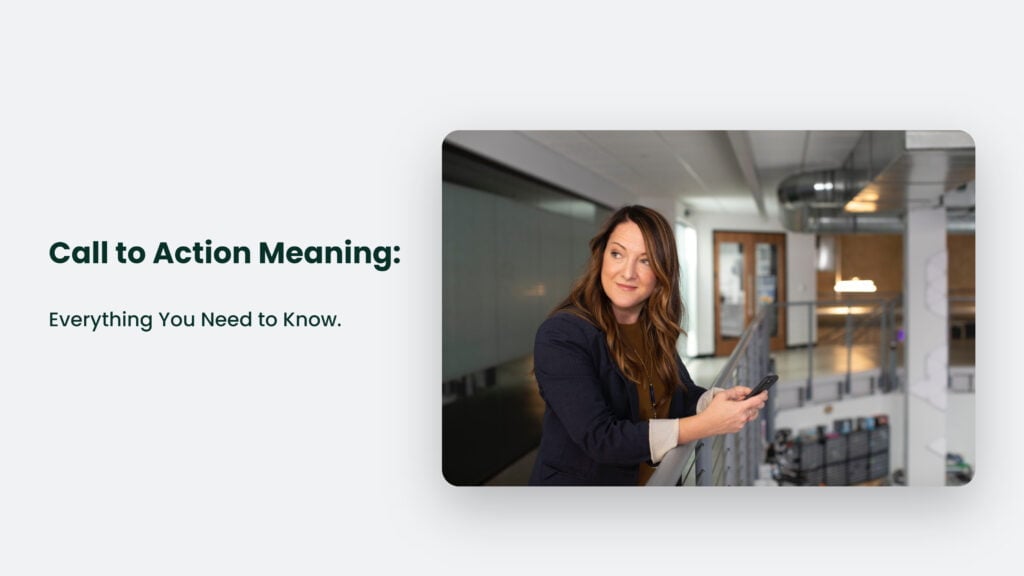Are you tired of visitors visiting your website and scrolling through your content but never actually taking Action? We know passive scrollers are a pretty hard crowd to get through
If yes, you must understand the importance of a Call to Action (CTA).
A CTA is a phrase or button encouraging your visitors to take a specific action. Whether it’s to make a purchase, sign up for a newsletter, or download a free guide, a well-crafted CTA can make a massive difference in the success of your website.
As a marketer and a blogger for the past five years, I’ve seen a strong CTA impact on a business. The final push can convert a passive reader into a loyal customer. But before we dive into how to craft the perfect CTA, let’s first understand the meaning behind it.

Call to Action meaning?
A CTA is a button or a line of text that tells your visitors what action you want them to take. It’s the link between your content and your goal. Whether you’re trying to increase sales, build your email list, or drive traffic to your blog, a CTA is crucial to making it happen.
A CTA is a finishing touch that ties everything together and encourages your visitors to take Action. Think of a CTA as the cherry on top of a sundae. Your content is the ice cream and toppings, but the sundae is complete with the cherry.
Why is a Call to Action Important?
A CTA is important because it guides your visitors towards your desired outcome. It’s like a roadmap that helps them navigate through your website and find what they’re looking for. With a CTA, your visitors may stay caught up and stay on your site.
But that’s not all. A well-crafted CTA can also:
- Increase conversions: A strong CTA can increase the number of visitors who take action on your site, which can lead to more sales, more sign-ups, and more leads.
- Build trust: A clear and concise CTA shows your visitors that you understand what they want and are committed to helping them achieve their goals. It can help build trust and establish a relationship with your audience.
- Improve user experience: A CTA that’s easy to find and understand can improve the overall user experience on your website. Visitors can quickly and easily take the action they want, leading to a better overall experience on your site.
How to Craft the Perfect Call to Action:
Crafting the perfect CTA is not rocket science, but it requires some thought and planning. Here are some tips to help you create a CTA that drives results:
- Make it clear and concise: Your CTA should be clear and concise, with a simple and straightforward message. Avoid using technical jargon or convoluted language that can confuse your visitors.
- Use strong action verbs: Use strong action verbs like “buy”, “download”, “subscribe”, or “sign up” to encourage your visitors to take action. These verbs create a sense of urgency and clarify what you want your visitors to do.
- Make it stand out: Your CTA should stand out on the page with a contrasting colour and clear, easy-to-read font. It will help grab the attention of your visitors and make it easy for them to find and click on your CTA.
- Place it in a prominent location: Your CTA should be placed in a prominent location on your page, such as above the fold or near the end of your content. It will increase the chances of your visitors seeing and clicking on your CTA.
- Personalize it: Personalize your CTA by using language that speaks directly to your audience. Use phrases like “Get your free guide” or “Join our community” to create a sense of belonging and make your CTA more appealing to your visitors.
- Test and adjust: Feel free to test different versions of your CTA to see what works best. Try different colours, placement, and language to see what resonates with your audience. Use data and analytics to track the performance of your CTA and make adjustments as needed.
- Make it benefit-driven: Your CTA should focus on the benefits that your visitors will receive by taking action. Use phrases like “Get instant access” or “Start saving today” to show your visitors what they’ll gain by clicking on your CTA.
Incorporating these tips into your CTAs will help you create a powerful tool that drives results for your business.
The Power of Storytelling in CTAs:
Storytelling is a powerful marketing tool and can also create effective CTAs. By weaving a story into your CTA, you can create an emotional connection with your audience and make your CTA more memorable.
For example, if you’re selling a weight loss program, your CTA could be “Join our community of success stories and start your weight loss journey today.” This story creates an emotional connection with your audience by highlighting the success of others and showing that they can achieve their weight loss goals.
Another example is if you’re promoting a travel company, your CTA could be “Embark on an adventure of a lifetime and create memories that will last a lifetime.” This story creates an emotional connection with your audience by highlighting the excitement and adventure of travel, making it more appealing to your audience.
Final Thoughts:
A call to action is a powerful tool in digital marketing, and it can make a huge difference in the success of your website. By understanding its meaning and importance and following the tips and techniques outlined in this article, you can create CTAs that drive results and help grow your business.
As the famous quote by marketing legend David Ogilvy says, “When you ask people to do something, provide them with a response mechanism.” So, include a clear and compelling CTA on your website, and watch your conversions soar!
In conclusion, a call to action is like the cherry on top of a sundae. It’s the finishing touch that ties everything together and encourages your visitors to take action. So, make sure to include a clear and compelling CTA on your website and savour the taste of success with every click!




